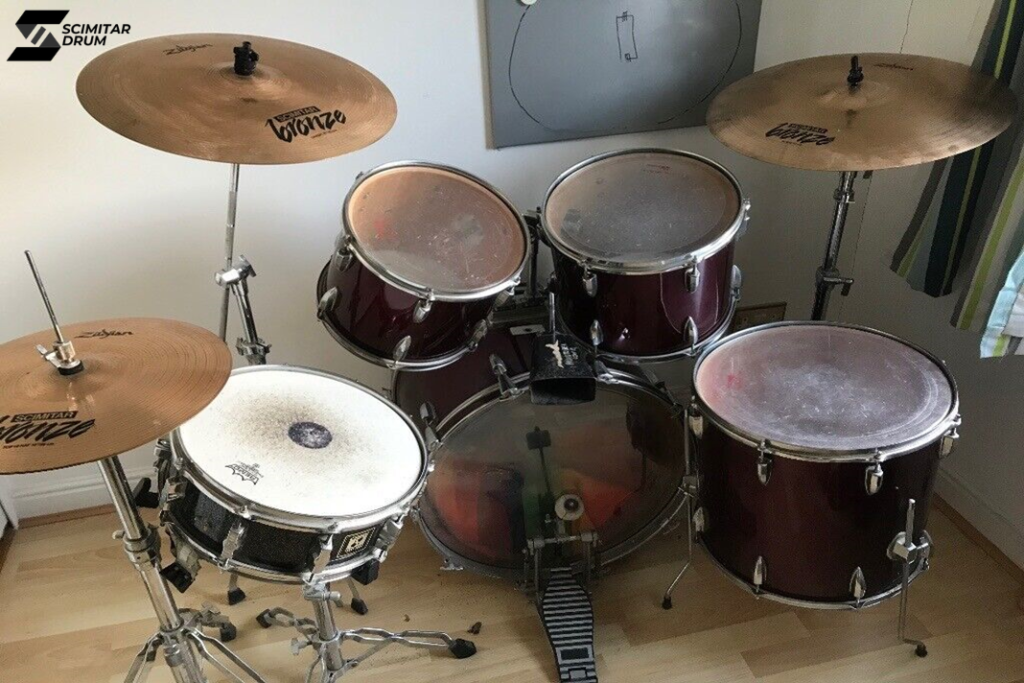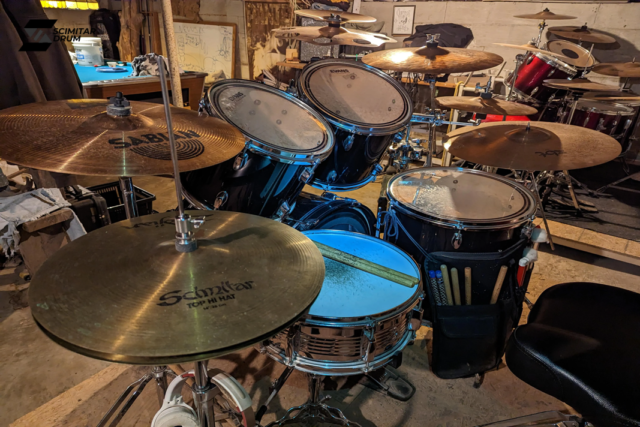The Scimitar Drum is more than an instrument; it represents cultural heritage. For centuries, its sound has played an integral part in ceremonies, celebrations and rituals around the world; its distinctive tone being used to maintain cultural identity across generational gaps. Music may often be thought of as universal language; yet the Scimitar Drum remains as an object that symbolizes continuity from past to present and future.
The Origin of the Scimitar Drum
Scimitar Drum History
Scimitar Drum’s history is as rich and diverse as the cultures who appreciate it. Originating in ancient regions known for their deep musical traditions, this instrument has evolved with each new era by adapting to meet their demands and influences. It takes its name from scimitar sword’s sharp, resonant sound cutting through the air like a blade.
Cultural and Regional Roots
Different cultures have contributed to the drum’s development, each adding their unique flair in terms of design and sound. Today, the Scimitar Drum can be found across various regions and musical traditions; each interpretation aligning perfectly with their cultural narratives.
Evolution of the Instrument Over Time
As with many traditional instruments, the Scimitar Drum has undergone gradual modifications in design and usage over the years. Although its core identity remains, materials, playing techniques, and even occasions of its use have evolved with culture over time.
Understanding the Scimitar Drum
Scimitar Drum Meaning
The Scimitar Drum represents more than its physical form; it symbolises life itself: rhythm of life, heartbeat of a community and continuity in cultural narratives. Its sound can serve as both a reminder of past achievements as well as celebration for what lies ahead.
Anatomy of the Scimitar Drum
The Scimitar Drum’s design embodies both simplicity and sophistication, often constructed from materials such as wood or animal hide. Crafted to produce deep, resonant sounds with its body typically curving to resemble that of a scimitar sword – hence both its name and symbolic significance.
Types of Materials Used in Its Construction
Scimitar Drums are typically constructed using traditional materials like wood, leather and metal; each contributes to its sound and durability. Modern versions might incorporate synthetic materials but its core remains true to tradition.
The Scimitar Drum in Traditional Music

Role in Cultural Ceremonies and Rituals
Scimitar Drums have long been an essential part of cultural ceremonies and rituals, serving to connect physical with spiritual realms through sound. Their strong vibrations serve to bring celebrations, religious services, and passage ceremonies closer together.
Scimitar Drum Cymbal: Adding Rhythm and Texture
Scimitar Drums stand out from the competition by including cymbals as an added feature, adding another dimension of rhythm and texture to their sounds. This combination highlights its versatility by adapting well to various musical contexts.
Comparison with Other Traditional Drums
While various cultures possess various traditional drums, the Scimitar Drum stands out due to its distinctive shape, sound and symbolic meaning. Where other drums may only focus on rhythmic elements of music composition, the Scimitar Drum often plays melodic parts too, making it both rhythmic and harmonic instruments in its use.
The Technique of Scimitar Drumming
Techniques and Styles
Playing the Scimitar Drum is an art that requires skill, practice and an acute grasp of rhythm. Traditional techniques involve intricate hand movements and precise timing that is essential in producing its distinctive sound. Different cultural contexts may result in differing styles but rhythm and melody principles remain constant.
The Importance of Practice and Mastery
Becoming adept at playing the Scimitar Drum takes dedication and continual practice. Anyone hoping to master this instrument must immerse themselves in the rhythms and traditions associated with their culture in order to master not just techniques but also stories embodied by this instrument.
Wig Drum Scimitar: Incorporating Modern Elements
The Wig Drum Scimitar represents a modern twist on a traditional instrument. By incorporating contemporary elements such as new materials or fusion styles, musicians can create innovative sounds while still paying homage to the drum’s traditional roots.
The Scimitar Drum in Modern Times
Fusion with Contemporary Music Genres
Today’s globalized world has created new opportunities for traditional instruments like the Scimitar Drum to thrive within modern music genres. Musicians are using its timeless sounds with jazz, rock, and electronic styles such as DJing to produce an intoxicating fusion that appeals to a broad audience while maintaining its cultural significance.
Interest in Traditional Instruments Is Growing Again
Traditional instruments, such as the Scimitar Drum, have seen an unexpected resurgence. This revival can be explained by people’s desire to reconnect with cultural roots while exploring their distinct sounds. As more people seek to preserve their heritage, this unique instrument has grown in popularity both as an artistic piece and cultural icon.
Scimitar Drum Wig: Symbol of Cultural Identity
Scimitar Drum Wigs are more than mere accessories; they serve as symbols of cultural identity. Wearing one while playing drum is an act of respect to past traditions and stories while honoring them through modern music performance, providing something meaningful for both old and young generations alike.
Scimitar Drum in Different Cultures

The Drum’s Influence Across Various Cultures
Around the world, the scimitar drum has influenced many different civilizations. The drum has been modified by every culture to suit its own musical traditions, creating a wide variety of sounds and meanings. The drum has a profound impact on both contemporary performances and sacred ceremonies.
Unique Adaptations in Different Regions
Different regions have put their own spin on the Scimitar Drum, resulting in a variety of styles and sounds. These adaptations reflect the diverse ways in which the drum has been integrated into cultural practices, from Africa to the Middle East, and beyond.
Preservation of Tradition through the Scimitar Drum
Efforts to Keep the Tradition Alive
Cultural organizations, music schools and musicians alike are actively striving to preserve the tradition of Scimitar Drum music for future generations through education, performances and recordings.
Role of Music Schools and Cultural Organizations
Music schools and cultural organizations play an essential role in teaching young musicians about the Scimitar Drum tradition. By offering classes, workshops, and performances they create an opportunity for them to gain an appreciation of their heritage as they develop skills necessary to keep it alive.
Challenges in Preserving Traditional Music

Modernization and Its Impact
As modernization spreads, traditional music runs the risk of being eclipsed by contemporary trends; yet, Scimitar Drum has managed to hold on by virtue of efforts undertaken by those who recognize its cultural value and recognize the need to preserve cultural heritage.
Balancing Tradition with Innovation
The challenge lies in striking a balance between traditionalist tendencies and cutting-edge innovation. Although maintaining traditional sounds and techniques for Scimitar Drum is important, experimentation and growth must also occur to remain relevant in an ever-evolving world.
The Future of the Scimitar Drum
Predictions for the Drum’s Evolution
As we look ahead, the Scimitar Drum is expected to continue evolving both in terms of construction and music usage. New materials, technologies and playing techniques may emerge; however, its primary role as a symbol of cultural tradition should remain undisturbed.
Continued Importance in Cultural Preservation
The Scimitar Drum will continue to play an essential role in cultural preservation, acting as a link between past and future. With its distinctive sound and deep-seated significance, this treasured cultural artefact will remain treasured among generations to come.
Frequently Asked Questions (FAQs)
1. What is the Scimitar Drum’s origin?
The Scimitar Drum originates from ancient regions with deep musical traditions, evolving over time to become a symbol of cultural identity.
2. How does the Scimitar Drum differ from other traditional drums?
Contrary to traditional drums, the Scimitar Drum often serves both rhythmic and melodic functions simultaneously, thanks to its distinct shape and cymbal. It also creates its signature sound.
3. Can the Scimitar Drum be used in modern music?
Yes, the Scimitar Drum is increasingly being incorporated into modern music genres, blending traditional sounds with contemporary styles.
4. What is the significance of the Scimitar Drum’s cymbal?
Cymbals add rhythm and texture to drum’s sound, intensifying its complexity while making it suitable for different musical environments.
5. How can one learn to play the Scimitar Drum?
Learning to play the Scimitar Drum requires dedication, practice, and often, guidance from experienced musicians or cultural organizations that specialize in traditional instruments.






































